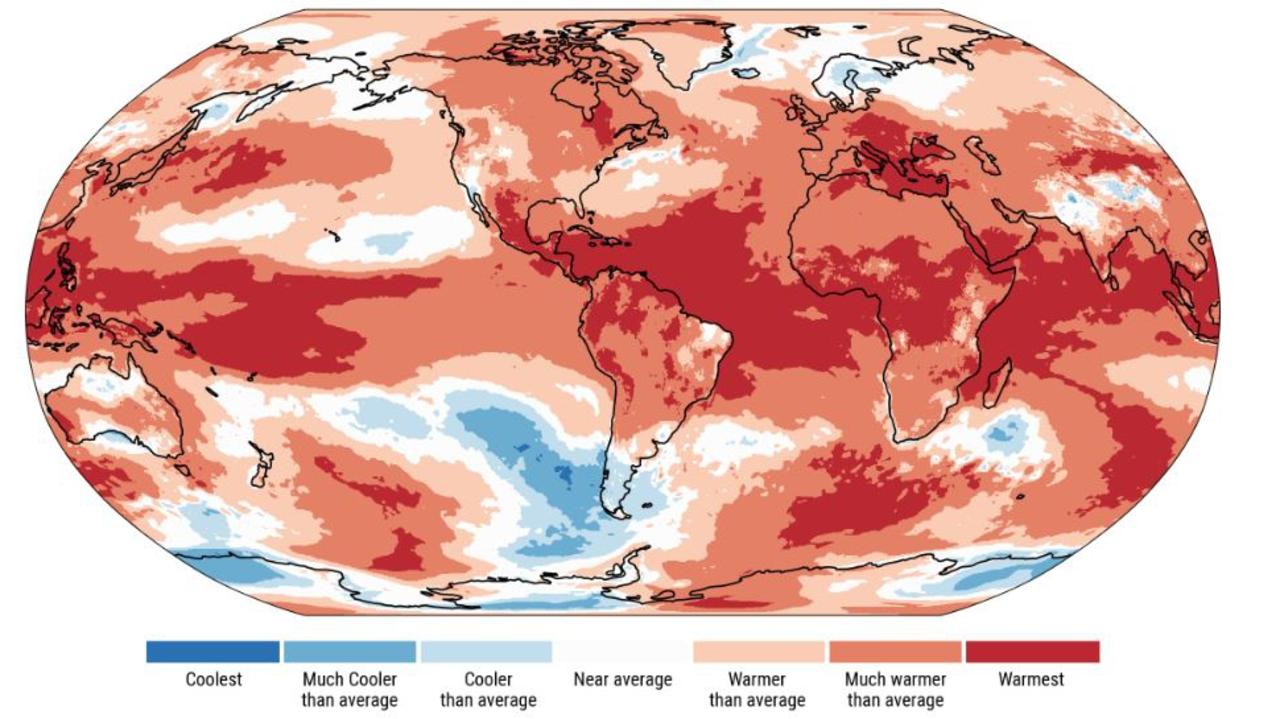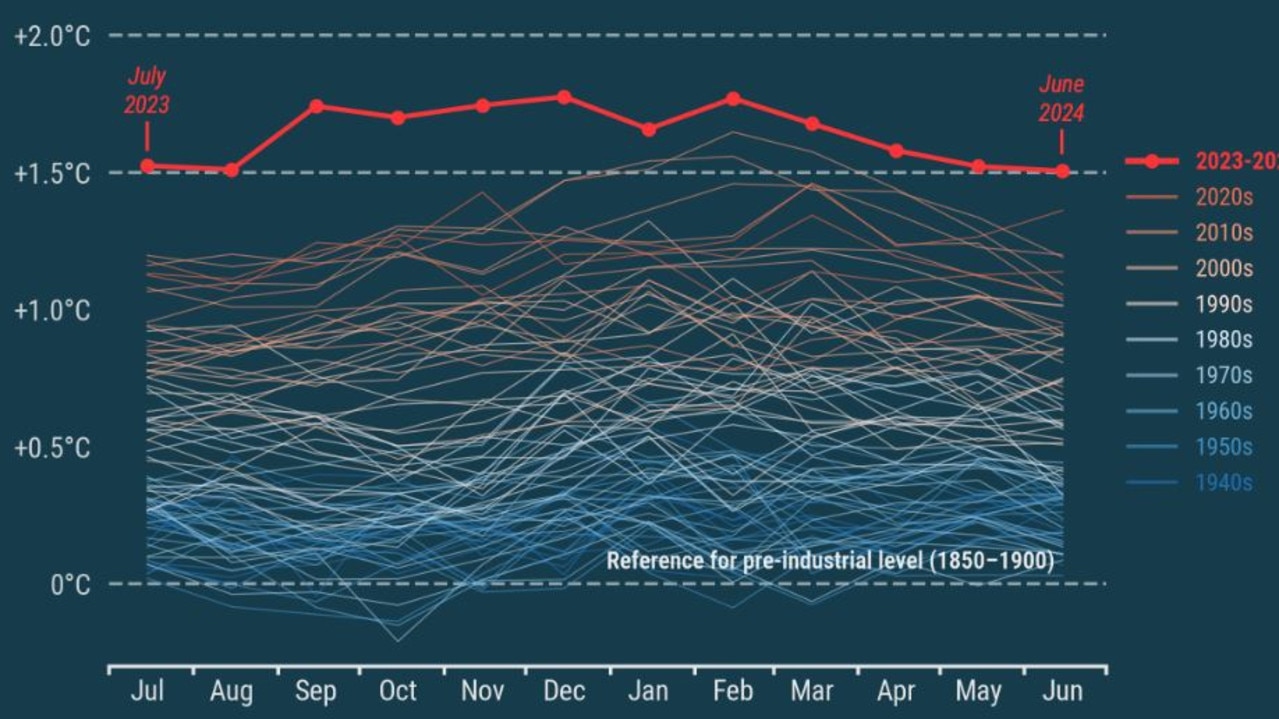Mapped: Why 2024 could be our hottest year
Australia is suffering through a wet and chilly winter, but heat records are being broken all around the world - prompting new ideas about how we should be dealing with it.
Dorothea Mackellar’s sunburnt country has been remarkably moist in 2024.
A drizzly summer with a national rainfall tally 19 per cent above average gave way to an autumn deluge (rainfall 32 per cent above average), and now a winter of bitterly cold mornings, reports of frost in the tropics, and – oh yes – more rain (9 per cent above average).
Mean, minimum and maximum temperatures have been a touch above their historical averages, but the primary talking point for Australia’s climate so far in 2024 would seem to be the rain. It’s been a wet, wet year for the wide brown land.
Meanwhile, the rest of the planet is having an absolute shocker.
June marked the 13th month in a row that the Earth’s average temperature set a new record for that respective month, according to the Copernicus Climate Institute. And already there is speculation as to whether 2024 could eclipse 2023 as the planet’s warmest year on record.


But the record books are constantly being rewritten. Last week Las Vegas sailed past its previous maximum temperature of 47.2°C with a new high of 48.8°C. Maybe tourists didn’t feel too uncomfortable inside those climate-controlled casinos, but there was no relief over the border in Palm Springs, California, which baked at 51°C.
Those grim highs follow a spate of heatwaves in other parts of the world. In Saudi Arabia, 1300 people making the hajj pilgrimage to Mecca died in extreme heat in June, with temperature readings at the Great Mosque topping 51.8°C. In India, a brutal heatwave brought the mercury close to 50°C in Delhi and Rajasthan in May, with widespread heat-related fatalities and water shortages. Extended runs of hot days have forced the closure of schools in southeast Asia, and major tourist attractions in Greece. And in Jahra, Kuwait, locals endured eight consecutive days with maximums above 50ºC, according to the World Meteorological Organisation (WMO).


“Heatwaves are becoming more common and intense, are starting earlier and ending later, and occurring simultaneously over several regions due to human-induced climate change,” WMO climate expert Alvaro Silva said.
“Unbearable temperatures over 40°C and even 50°C are increasingly frequent in many parts of the world, paralysing society and posing a major threat to human health and wellbeing.”
There are concerns the planet may have already irreversibly warmed by more than 1.5°C
– the lower threshold mark of the Paris Agreement – because global average temperatures for each of the past 12 months have registered at or above that mark.
But, technically, that threshold has not yet been breached – if only because the Paris Agreement sets targets based on average data over 20 or 30 years, not 12 months.

Professor Lesley Hughes from the Climate Council said the trend towards warmer temperatures had long been predicted, but the rate of that change was unexpected.
“There wouldn’t be many climate scientists that would be terribly surprised [by the recent temperatures], though I think they would all be concerned the world is warming up even more rapidly than perhaps some of the climate models predicted,” she said.
“These temperatures we’re seeing globally, both in the air and in the oceans, should be a wake-up call for anybody involved in climate policy that whatever we’re doing, we need to do more, and faster.”
Others think the quickening pace of global warming could prompt research, or at least debate, on more radical potential solutions – especially given global greenhouse gas emissions are still rising.
Known as solar geoengineering, there are a range of these more drastic ideas, but just one is the dispersal of fine aerosol particles in the upper atmosphere to reflect sunlight back into space.


Climate researcher Dr Jan Zika from the University of NSW said solar geoengineering ideas were “coming more into the mainstream”.
Recent research on a possible link between ocean warming and reductions in sulfur dioxide in the atmosphere (owing to a global change in shipping fuels in 2020) had generated a lot of interest, he said.
“When I was at the AGU [American Geophysical Union] conference in San Francisco last year I noticed an increasing number of sessions on the topic of geoengineering,” he said.
“There’s more work being done on it, there’s more interest in it, and the people that are interested are becoming more adamant that it has to be seen as an option.”
But other climate scientists still “dismiss it out of hand … as a crazy thing to even contemplate,” Assoc Prof Zika said.
Professor Hughes said most scientists viewed geoengineering with “trepidation” as it was a “huge risk”.
“Now, climate change is also a huge risk,” she said.
“I think most scientists like me would rather see a redoubling of efforts to lower emissions than to move into a Plan B. We could get there, I suppose, if we don’t redouble our efforts to reduce the root cause of climate change, which is the burning of fossil fuels.
“But we’re not at the Plan B stage yet.”
More Coverage
Originally published as Mapped: Why 2024 could be our hottest year



